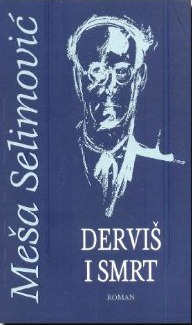| Revision as of 17:48, 28 June 2015 edit58.172.180.117 (talk) →Plot← Previous edit | Revision as of 06:56, 21 August 2015 edit undoDukisuzuki (talk | contribs)114 editsm I COME FROM A MUSLIM FAMILY FROM BOSNIA, BUT BY ETHNICITY I AM A SERB. I BELONG TO SERBIAN LITERATURE' - Mehmed "Mesa" SelimovicNext edit → | ||
| Line 24: | Line 24: | ||
| }} | }} | ||
| '''''Death and the Dervish''''' ({{lang-sh|Derviš i smrt}}/Дервиш и смрт) is a novel by ] writer ], published in 1966.<ref>{{cite web|url=http://www.publishersweekly.com/978-0-8101-1297-1|title=Death and the Dervish|publisher=Publishers Weekly|date=|accessdate=29 March 2015}}</ref> The novel was made into into a 1974 feature-length film ]. | '''''Death and the Dervish''''' ({{lang-sh|Derviš i smrt}}/Дервиш и смрт) is a novel by ]<ref>{{cite web|title=Sto godina od rođenja Meše Selimovića|url=http://www.rts.rs/page/stories/sr/story/16/Kultura/654651/Sto+godina+od+ro%C4%91enja+Me%C5%A1e+Selimovi%C4%87a|publisher=RTS.rs|accessdate=1 June 2014}}</ref><ref>{{cite web|title=ПИСМО МЕШЕ СЕЛИМОВИЋА САНУ, КОЈИМ ПОТВРЂУЈЕ ДА ЈЕ СРБИН|url=http://www.srpskikulturniklub.com/selimovic|publisher=srpskikulturniklub.com|accessdate=30 May 2014}}</ref><ref>{{cite news|title=Ćerke velikog Meše Selimovića žive u Beogradu: Bosnu nose samo u sećanjima!|url=http://www.kurir-info.rs/cerke-velikog-mese-selimovica-i-danas-zive-u-beogradu-bosnu-nose-samo-u-secanjima-clanak-1280195|accessdate=30 May 2014|newspaper=kurir-info.rs}}</ref><ref name=serb>]: '''', Dragan BOGUTOVIĆ, 9 July 2010 {{sr icon}}</ref><ref>http://www.jergovic.com/subotnja-matineja/mesa-selimovic-ateist-koji-se-usrdno-molio/ "Potičem iz muslimanske porodice iz Bosne, a po nacionalnoj pripadnosti sam Srbin. Pripadam srpskoj literaturi"</ref> writer ], published in 1966.<ref>{{cite web|url=http://www.publishersweekly.com/978-0-8101-1297-1|title=Death and the Dervish|publisher=Publishers Weekly|date=|accessdate=29 March 2015}}</ref> The novel was made into into a 1974 feature-length film ]. | ||
| ==Plot== | ==Plot== | ||
Revision as of 06:56, 21 August 2015
For the 1974 film, see Death and the Dervish (film). | |
| Author | Meša Selimović |
|---|---|
| Original title | Derviš i smrt |
| Language | Serbo-Croatian |
| Genre | Novel |
| Publisher | Northwestern University Press |
| Publication date | 1966 |
| Publication place | SFR Yugoslavia |
| Media type | Print (Hardback & Paperback) |
| Pages | 473 |
Death and the Dervish (Template:Lang-sh/Дервиш и смрт) is a novel by Serb writer Meša Selimović, published in 1966. The novel was made into into a 1974 feature-length film of the same name.
Plot
Sheikh Nuruddin is a respected dervish in an Islamic monastery in eighteenth century Bosnia. He learns his brother Harun has been arrested by the Ottoman authorities but he struggles to determine exactly what happened and what he should do. He narrates the story as a kind of elaborate suicide note “from a need stronger than benefit or reason” and regularly misquotes (or misunderstands) the Quran, the sacred scriptures of his faith. Slowly the Sheikh starts to probe and question society, power and life in general. Speaking the truth leads to his being physically assaulted in the streets and even arrested briefly. Ultimately he fights and challenges the injustice of the world by employing deceit which succeeds at the expense of innocent life. The Sheikh replaces the old Kadı but Nuruddin is in turn corrupted by the need to uphold the original deceit.
Principal characters
- Sheikh Ahmed Nuruddin —the protagonist who is a religious everyman. His name Ahmed means friend in Arabic, whilst Nuruddin means “light of the faith”.
- Hasan—Nuruddin’s principle friend outside the tekke.
- Mullah Yusuf—the young student Nuruddin has brought into the tekke as an orphan, who spies on him for outsider interests.
Subject Matter
The principle theme of Death and the Dervish is “malodušnost”, a Serbo-Croatian word meaning diminished or reduced souls. The most popular interpretation of this popular novel is that Selimovic employed a fictional Ottoman setting to obscure a real critique of life in Communist Yugoslavia. Another important component is the fact that the story reflects a real life incident in the author’s own life when his brother, an ardent Communist functionary, was imprisoned and executed by Communist authorities after the war as an example to others for a very minor offence.
References
- "Sto godina od rođenja Meše Selimovića". RTS.rs. Retrieved 1 June 2014.
- "ПИСМО МЕШЕ СЕЛИМОВИЋА САНУ, КОЈИМ ПОТВРЂУЈЕ ДА ЈЕ СРБИН". srpskikulturniklub.com. Retrieved 30 May 2014.
- "Ćerke velikog Meše Selimovića žive u Beogradu: Bosnu nose samo u sećanjima!". kurir-info.rs. Retrieved 30 May 2014.
- Večernje Novosti: Pronašao mir u Beogradu, Dragan BOGUTOVIĆ, 9 July 2010 Template:Sr icon
- http://www.jergovic.com/subotnja-matineja/mesa-selimovic-ateist-koji-se-usrdno-molio/ "Potičem iz muslimanske porodice iz Bosne, a po nacionalnoj pripadnosti sam Srbin. Pripadam srpskoj literaturi"
- "Death and the Dervish". Publishers Weekly. Retrieved 29 March 2015.
This article about a 1960s novel is a stub. You can help Misplaced Pages by expanding it. See guidelines for writing about novels. Further suggestions might be found on the article's talk page. |